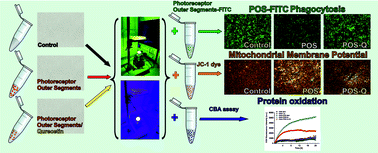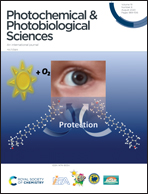Quercetin protects ARPE-19 cells against photic stress mediated by the products of rhodopsin photobleaching†
Abstract
Although the primary biological function of retina photoreceptors is to absorb light and provide visual information, exposure to intense light could increase the risk of phototoxic reactions mediated by rhodopsin photobleaching products (RPBP) that might accumulate in photoreceptor outer segments (POS). Here we investigated whether quercetin can modify the phototoxic potential of RPBP under in vitro photic stress conditions. ARPE-19 cells or quercetin enriched cultures pre-loaded with rhodopsin-rich POS isolated from bovine retinas were irradiated with green light to photobleach rhodopsin, and subsequently with blue light. Survival of cells was determined by MTT assay and propidium iodide staining. Changes in mitochondrial membrane potential (MMP) were assessed by JC-1 staining. Protein hydroperoxides, formed by photosensitized oxidation, mediated by RPBP, were analyzed in cells and in a model system with bovine serum albumin (BSA), using the coumarin boronic acid fluorogenic probe. The effect of photic stress on specific phagocytosis of RPE cells was determined by flow cytometry. Photoreactivity of POS with and without quercetin was analyzed by EPR oximetry and EPR spin trapping. Cytotoxicity measurements and MMP analyses confirmed that supplementation with quercetin protected ARPE-19 cells against photic stress mediated by rhodopsin-rich POS. Quercetin significantly reduced the inhibitory effect of RPBP-mediated stress on POS phagocytosis and the RPBP ability to photooxidize cellular proteins or BSA. The data support the hypothesis that quercetin may efficiently diminish the phototoxic action of retinoids, necessary for restoring the phagocytic function of ARPE-19 cells.

- This article is part of the themed collection: The World Congress on Light and Life, Barcelona 2019


 Please wait while we load your content...
Please wait while we load your content...